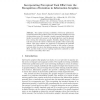Free Online Productivity Tools
i2Speak
i2Symbol
i2OCR
iTex2Img
iWeb2Print
iWeb2Shot
i2Type
iPdf2Split
iPdf2Merge
i2Bopomofo
i2Arabic
i2Style
i2Image
i2PDF
iLatex2Rtf
Sci2ools
DIAGRAMS
2004
Springer
2004
Springer
Incorporating Perceptual Task Effort into the Recognition of Intention in Information Graphics
The rapidly increasing availability of electronic publications containing information graphics poses some interesting challenges in terms of information access. For example, visually impaired individuals should ideally be provided with access to the knowledge that would be gleaned from viewing the information graphic. Similarly, digital libraries must take into account the content of information graphics when constructing indices. This paper outlines our approach to recognizing the intended message of an information graphic, focusing on the concept of perceptual task effort, its role in the inference process, our rules for estimating effort, and the results of an eye tracking experiment conducted in order to evaluate and modify those rules.
Artificial Intelligence | DIAGRAMS 2004 | Information Graphic | Perceptual Task Effort | Publications Containing Information |
| Added | 20 Aug 2010 |
| Updated | 20 Aug 2010 |
| Type | Conference |
| Year | 2004 |
| Where | DIAGRAMS |
| Authors | Stephanie Elzer, Nancy Green, Sandra Carberry, James Hoffman |
Comments (0)

